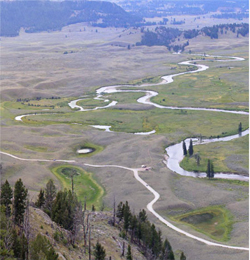Yellowstone amphibians in decline due to climate change
Yellowstone amphibians in decline due to climate change
mongabay.com
October 27, 2008
Climate change appears to be responsible for a “marked drop” in the population of three of four species of amphibian once common to Yellowstone National Park, the world’s oldest national park, report researchers writing in Proceedings of the National Academy of Sciences.
Using surveys and remote sensing to monitor and record changes in wetlands in northern Yellowstone National Park, Sarah McMenamin of Stanford University and colleagues linked declining amphibian populations to drier and warmer conditions over the past 60 years, including a four-fold increase in the number of number of permanently dry ponds over the past 16 years.
“Of the ponds that remain, the proportion supporting amphibians has declined significantly, as has the number of species found in each location,” the authors write. “Our results indicate that climatic warming already has disrupted one of the best-protected ecosystems on our planet and that current assessments of species’ vulnerability do not adequately consider such impacts.”
 A view of the glacially modified topography of Lamar Valley in Northern Yellowstone. Slough Creek is visible, as are the many permanent and ephemeral glacial kettle ponds. These ponds are breeding and living habitat for four different species of amphibian. Widespread drought is causing the desiccation and destruction of many of these habitats, which has caused significant and severe declines in regional amphibians. Photo by Sarah McMenamin in 2007 |
In other words, the establishment of conservation areas alone will not be enough to protect some species from the impacts of climate change. The researchers add that changes in Yellowstone are taking place at a rate faster than expected.
“Our data suggest that climatic change is causing substantial changes to the hydrologic landscape and that amphibian populations are being damaged by both habitat loss and other climate-associated mechanisms,” they write. “Precipitous declines of purportedly unthreatened amphibians in the world’s oldest nature reserve indicate that the ecological effects of global warming are even more profound and are happening more rapidly than previously anticipated.”
The species native to Northern Yellowstone include the blotched tiger salamander (Ambystoma tigrinum melanostictum), the boreal chorus frog (Pseudacris triseriata maculata), the Colombia spotted frog (Rana
luteiventris, formerly Rana pretiosa), and the less common boreal toad (Bufo boreas boreas). No exotic amphibians are present in the region.
Sarah K. McMenamin, Elizabeth A. Hadly, and Christopher K. Wright (2008). Climatic change and wetland desiccation cause amphibian decline in world’s oldest national park. PNAS Early Edition for the week of October 27, 2008.
Related articles
Rainforest biodiversity at risk from global warming
(10/9/2008) Climbing temperatures may doom many tropical species to extinction if they are unable to migrate to higher elevations or cooler latitudes, report researchers writing in Science.
Amphibians face mass extinction
(8/11/2008) Amphibians are in big trouble. At least one third of the world’s 6,300 known species are threatened with extinction, while at least 200 species have gone extinct over the past 20 years. Worryingly the outbreak of a deadly fungal disease, chytridiomycosis, is spreading throughout the tropics leaving millions of victims. A new study, published in the early edition of the Proceedings of the National Academy of Sciences, warns that there is “little time to stave off a potential mass extinction” of frogs, salamanders, and caecilians.
Moving species may be only way to save them from climate change
(7/17/2008) Desperate times call for desperate measures, according to a new paper in Science. conservation scientists from the US, the UK, and Australia are calling for the consideration of a highly controversial conservation technique: assisted migration. According to the policy piece, species would be relocated to sites “where they do not currently occur or have not been known to occur in recent history”.
Global warming causes plants to move to higher elevations
(6/26/2008) Global warming has caused many plant species to move to higher elevations, report researchers writing in the journal Science.
Protected areas must be adapted to survive global warming
(4/3/2007) Protected areas can play an important role in reducing biodiversity loss due to global warming, reports a new study published March 30 in the journal Frontiers in Environment and Ecology (FREE). The research says that conservation efforts must factor in shifts in species’ ranges to be successful.
 |
Extinction, like climate change, is complicated
(3/26/2007) Extinction is a hotly debated, but poorly understood topic in science. The same goes for climate change. When scientists try to forecast the impact of global change on future biodiversity levels, the results are contentious, to say the least. While some argue that species have managed to survive worse climate change in the past and that current threats to biodiversity are overstated, many biologists say the impacts of climate change and resulting shifts in rainfall, temperature, sea levels, ecosystem composition, and food availability will have significant effects on global species richness.














